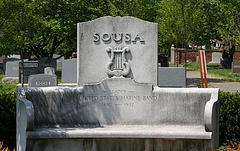 |
| U.S. Army Band, "Pershing's Own" |
 |
| Rossini: wrote for band? Yep... |
As I have been in the process of revisiting and revising the remainder of the season, I have held off an assessment of the February and April concerts; now that everything is set, these can be examined in terms of:
- Variety
- Historical vs. contemporary elements
- Enjoyment for the audience (we can stretch them a bit, but I would never want to present what one colleague calls a <insert name of well known wind conductor> death concert).
Frank Ticheli: Sanctuary
Derek Bourgeois: Serenade, Op. 22
George Bizet/Jan Van Duffel: “Habanera,” from Carmen
Katherine Dalin, mezzo-soprano
Nebosa S. Macura: Echoes of Rascia
John Philip Sousa: Revival March
INTERMISSION
Richard Strauss: Serenade, Op. 7
Wolfgang Amadeus Mozart/DCamp: Piano Concerto in C major, K. 503
I. Allegro maestoso
Joan Trapp, piano
Steven Bryant: Stampede
Initially examining the historical aspect, the works, while primarily from the twentieth century, have compositional dates ranging from 1786 (Mozart) to 2008 (Macura). It features well-known composers from all media (Mozart, Bizet, and Strauss), the wind medium (Ticheli, Sousa, et al) as well as a young UW-Madison graduate (Macura) who took up my call to write for the wind medium.. Echoes of Rascia is a particularly evocative work based on ancient Serbian chant as well as a great deal of original material.
Variety: The Bourgeois Serenade was originally written as a tongue in cheek wedding processional, with the joke being that the piece is written in the "unwalkable" meter of 11/8. Once the listener gets accustomed to that oddity, the composer vaults into 13! Surprisingly enough, every ensemble that I have ever played this work with has problems on the one "regular" bar (12/8) found near the conclusion.
Tradition: Of course, the name of John Philip Sousa is ubiquitously associated with band concerts. The Revival March, however, is probably one of his least known works even though it was Sousa's first published work and was premiered by none other than the Philadelphia Orchestra. The "sweet" association with the work is my own play on words, as Sousa bases his trio strain on the old camp meeting tune, "The Sweet By and By."
 |
| Frank Ticheli |
Nationalism vs. Eclectic: Obviously, there are acknowledged European masters on the program. But it also includes an international mix of contemporary composers as well. Ticheli and Bryant are both extremely well known in the wind medium (and therefore will not be found in music history texts) as each has contributed in large part to the repertoire.
Does my program measure up? I want to think so, but maybe it's a very biased assessment. I do know that I put a great deal of time and thought into each work I decide to perform. And how many of the works are new to my own personal repertoire? All but two....I have to continue to learn and study as well.

No comments:
Post a Comment